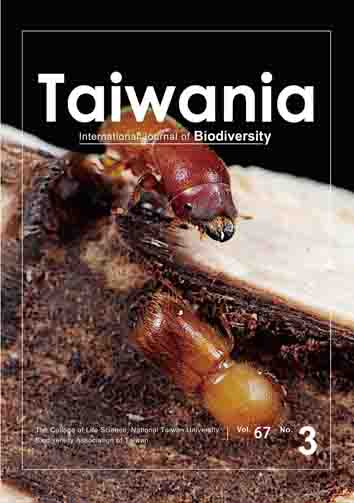Note
Confirmation of the taxonomic status of Lysionotus pterocaulis (Gesneriaceae) supported by morphological and molecular evidence
Zhang-Ping Huang, Zhao-Cen Lu, Chun-Yu Zou, Meng-Qi Han, Qiang Zhang, Wei-Bin Xu
Published on: 14 August 2022
Page: 455 - 460
DOI: 10.6165/tai.2022.67.455
Abstract
Lysionotus serratus var. pterocaulis C.Y.Wu ex W.T.Wang was initially described as a variety, but was treated as an independent species L. pterocaulis (C.Y.Wu ex W.T.Wang) H.W.Li in 1991, although this status was not always retained by subsequent authors. Our observation of wild living plants demonstrated that L. pterocaulis is obviously distinguishable from L. serratus D.Don through its longitudinally angled stems with wings, yellowish to white corolla, tubular to slightly funnelform tube, and linear-lanceolate calyx lobes. Furthermore, the molecular phylogenetic analyses indicated that L. pterocaulis is not clustered with L. serratus but embedded in a different lineage. Therefore, L. pterocaulis is confirmed to be an independent species and an updated description is provided.
Keyword: Biodiversity hotspot, limestone flora, Lysionotus serratus, molecular phylogeny, taxonomy
Literature Cited
Akhil, M.K., N. Krishna, A. Amrutha and S. Nampy 2021. A new species of Lysionotus (Gesneriaceae) from Arunachal Pradesh, India. J. Asia-Pacific Bio. 14(1): 116–120.
DOI: 10.1016/j.japb.2020.09.009View Article
Google Scholar
Chun, W.-Y. 1946. Gesneriacearum plantae novae Sinicarum. Sunyatsenia 6: 271–304.
Clarke, C.B. 1888. Gesneriaceae, Hemiboea. InClarke, C.B. Hooker’s Icon. Pl. 18: t. 1798.
Don, D. 1822. Descriptions of two new genera of Nepaul plants. Edinb. Phil. J. 7: 82–86.
Doyle, J.J. and J.L. Doyle 1987. A rapid DNA isolation procedure for small quantities of fresh leaf tissue. Phytoche. Bull. 19:11–15.
Edgar, R.C. 2004. MUSCLE: multiple sequence alignment with high accuracy and high throughput. Nucleic Acids Res. 32(5): 1792–1797.
DOI: 10.1093/nar/gkh340View Article
Google Scholar
Fredrik, R., T. Maxim, V.D.M. Paul, D.L. Ayres, D. Aaron and H. Sebastian 2012. MrBayes 3.2: Efficient Bayesian Phylogenetic Inference and Model Choice Across a Large Model Space. Syst. Bio. 61(3): 539–542.
DOI: 10.1093/sysbio/sys029View Article
Google Scholar
GCCC 2022. The Checklist of Gesneriaceae in China. http://gccc.gxib.cn/cn/about-68.aspx (accesse 12 February 2022).
GRC 2022. Gesneriaceae Resource Centre. https://padme.rbge.org.uk/grc/ (accesse 12 February 2022).
Hall, T.A. 1999. BioEdit: A User-Friendly Biological Sequence Alignment Editor and Analysis Program for Windows 95/98/NT. Nucleic Acids Symposium Series 41(41): 95–98.
Hilliard, O. and B.L. Burtt 1995. Old World Gesneriaceae. IV. Notes on Didymocarpus and Lysionotus. Edinb. J. Bot. 52(2): 215–224.
DOI: 10.1017/S0960428600000974View Article
Google Scholar
IUCN 2022. Guidelines for Using the IUCN Red List Categories and Criteria, version 15. Prepared by Standards and Petitions Subcommittee. Downloadable from: http://www.iucnredlist.org/documents/RedListGuidelines.pdf (accessed 12 February 2022).
Joe, A., V.S. Hareesh and M. Sabu 2017. A new taxon of Lysionotus (Gesneriaceae) from northeastern India. Taiwania 62(4): 337–339.
DOI: 10.6165/tai.2017.62.337View Article
Google Scholar
Li, X.-W. 1991. Gesneriaceae. In: Wu, Z.-Y. (ed.) Flora Yunnanica 5. Science Press, Beijing, pp. 512–689.
DOI: 10.1016/S0367-2530(17)30474-7View Article
Google Scholar
Li, Z.-Y. and Y.-Z. Wang 2004. Plants of Gesneriaceae in China. Henan Science and Technology Publishing House, Zhengzhou, pp. 381–412.
M?ller, M., A. Forrest, Y.-G. Wei and A. Weber 2011. A molecular phylogenetic assessment of the advanced Asiatic and Malesian didymocarpoid Gesneriaceae with focus on non-monophyletic and monotypic genera. Plant Syst. Evol. 292(3-4): 223–248.
DOI: 10.1007/s00606-010-0413-zView Article
Google Scholar
Nong, D.-X., W.-B. Xu, W.-H. Wu and Y. Liu 2010. Lysionotus fengshanensis Yan Liu & D.X.Nong sp. nov. (Gesneriaceae) from Guangxi, China. Nordic J. Bot. 28(6): 720–722.
DOI: 10.1111/j.1756-1051.2010.00857.xView Article
Google Scholar
Pellegrin, F. 1930. Gesn?riac?es. In: Lecomte, H., H. Humbert, F. Gagnepain (eds) Flore G?n?rale de l’Indo-Chine 4: 487–565. Paris, Masson.
Posada D. 2008. jModelTest: phylogenetic model averaging. Mol Biol Evol. 25(7): 1253–1256.
DOI: 10.1093/molbev/msn083View Article
Google Scholar
Stamatakis, A. 2006. RAxML-VI-HPC: maximum likelihood-based phylogenetic analyses with thousands of taxa and mixed models. Bioinformatics, 22(21): 2688–2690.
DOI: 10.1093/bioinformatics/btl446View Article
Google Scholar
Taram, M., A.P. Das and H. Tag 2019. Lysionotus chatungii–a new species of Gesneriaceae from Arunachal Pradesh in north-eastern India. Pleione 13(2): 399–402.
DOI: 10.26679/Pleione.13.2.2019.399-402View Article
Google Scholar
Tian, J., C.-F. Zhang, S. Peng, J.-J. Wang, Y. Wang, G.-W. Hu and Q.-F. Wang 2020. Lysionotus coccinus (Gesneriaceae), a new species from southwestern Yunnan, China. Nordic J. Bot. 38(11): e02912.
DOI: 10.1111/njb.02912View Article
Google Scholar
Wang R.-J., Y. Liu and S.-L. Chen 2017. Species Catalogue of China: Volume 1 Plants, Spermatophytes 1(Ⅷ). Science Press, Beijing, pp. 193–234.
Wang, W.-T. 1983. Revision of Lysionotus in China. Guihaia 3: 249–284.
Wang, W.-T. 1990. Gesneriaceae. In: Wang, W.T. (ed.) Flora Reipublicae Popularis Sinicae 69. Science Press, Beijing, pp. 125–581.
Wang, W.-T., K.-Y. Pan, Z.-Y. Li, A.L. Weitzman and L.E. Skog 1998. Gesneriaceae. In: Wu, Z.Y. & P.H. Raven (eds.) Flora of China. vol. 18. Science Press, Beijing; Miss. Bot. Gard. Press, St. Louis, pp. 244–401.
Weber, A., Y.-G. Wei, S. Sontag and M. Moller 2011. Inclusion of Metabriggsia into Hemiboea (Gesneriaceae). Phytotaxa 23(1): 37.
DOI: 10.11646/phytotaxa.23.1.2View Article
Google Scholar
Xu, W.-B., J. Guo, B. Pan, Q. Zhang and Y. Liu 2017. Diversity and distribution of Gesneriaceae in China. Guihaia 37(10): 1219–1226.


